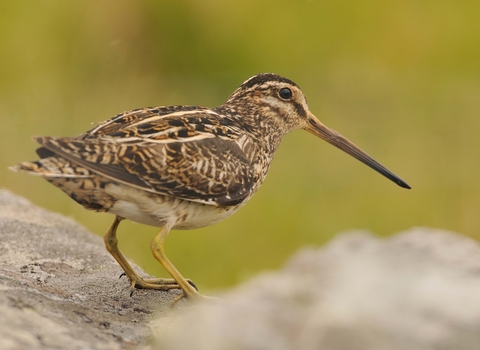
©Fergus Gill/2020VISION
Snipe
Listen out for the 'drumming' sound of a male snipe as it performs its aerial courtship display. It's not a call, but actually its tail feathers beating in the wind. Snipe live on wet grassland, marshes and moorlands throughout the UK.
Scientific name
Gallinago gallinagoWhen to see
January to DecemberSpecies information
Category
Statistics
Length: 25-27cmWingspan: 46cm
Weight: 110g
Average lifespan: 3 years
Classified in the UK as Amber under the Birds of Conservation Concern 5: the Red List for Birds (2021). Protected in the UK under the Wildlife and Countryside Act, 1981.
About
A medium-sized wader, the snipe lives in marshes, wet grassland and moorlands, where it nests in simple scrapes. It uses its long, probing bill to find insects, earthworms and crustaceans in the mud, typically swallowing prey whole. During the breeding season, males can be heard making a unique 'drumming' sound as their tail feathers vibrate in the wind as they perform their aerial courtship displays.How to identify
Snipe are brown, with an intricate pattern of black and gold bars, and a stripy brown and gold head. They have short, greyish-green legs and a very long, straight bill. The snipe is smaller than the similar-looking woodcock and is a bird of grasslands and moorlands, rather than woodlands.Distribution
Widespread; a fairly common breeding bird and winter visitor, found on wet grassland and marshes.In our area
Often spotted at wetland sites such as Wood Lane Nature Reserve near Ellesmere and Venus Pools near Shrewsbury. Keep track of the latest bird sightings at Wood Lane here.
Did you know?
Snipe have a flexible tip to the beak that is full of nerves; this helps them to feel for worms deep underground and then open the end of their beak to grab them.Watch
Common Snipe (https://vimeo.com/444193582)
Common Snipe by John Bridges
Often spotted at wetland sites such as Wood Lane Nature Reserve near Ellesmere and Venus Pools near Shrewsbury. Keep track of the latest bird sightings at Wood Lane here.

